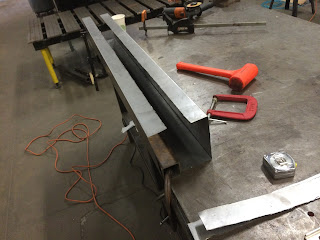I've had a 4x8' sheet of 22ga steel sitting in my garage (leaned up against my hexayurt) for probably about six months now, since starting
Mocobe really. So, it felt good to finally drop it in the back of my pickup truck and haul it over to the shop to start making the sheath for the linear drive unit. (22ga was the thinnest I could find locally that wasn't galvanized; I was shooting for 25ga, but it wasn't available.)
First things first, I took the
rail holders that I had bolted on with some difficulty, and welded them in place. I can't remember why I thought that bolting them would be necessary; I think I was under the impression that they might need some lateral play, in order to make sure the rails slid on properly at both ends, since they're separated by 8 feet. That is certainly not the case, the rails fit on fine with the holders welded in place more-or-less-straight.
I also cut a couple of segments of 3/8" pipe (same pipe I was using for
bolting together the two 4' segments) and welded on a couple of holders for 1/8" copper refrigeration pipe, to use for pilot lights. Some photos of the pilot lights below.
These are hooked up to a 1/2 PSI regulator, and have 1/16" holes in them, but they still need a needle valve to dial back the flow rate a lot. I wrapped these in a small amount of steel wool, but I found that it wasn't effective at preventing simulated blowouts, so I might need more.
Now: On to the fun stuff!
Cutting the sheet metal was a bit of a pain. There are a lot of options here, but few good ones:
- Band saw: too unwieldy for a piece this large, and too hard to make straight cuts
- Plasma torch: Excellent! Except that TechShop doesn't have one anymore. They did years ago, but it broke and they never replaced it.
- Oxy acetylene torch: Too messy for something this thin. And I don't remember how to use it.
- Water jet: Too expensive for a simple straight cut.
I decided in the end to go old school, and used an angle grinder. Simple, reliable, and hard to screw up. I tried a few things, with different cuts, and found that I could make a decent straight cut free-hand, but that using a guide made it a lot easier. I found a 1.5' piece of steel scrap with a 1/2" 90 degree bend in it that was perfect, and if I keep doing it this way, I'll probably make a longer one. But, ideally, I'd like to do this with a plasma cutter in the future. You can use it with an aluminum guide and make quick work of it.
The layout for the sheath was to take a 4' long sheet, and bend it into the sheath of the correct shape, leaving a gap on top for the flame to exit. Here's the plan:

I can use the
finger brake for the first two bends easily. After bend 2, I leave it in the brake, and make the third bend, on the first 6" segment. The finger brake only opens about 3/4 of an inch, and after the third bend, it's got 6" vertical behind it, but I can work it out with a bit of effort by
pivoting the piece. But I definitely can't make the last bend this way, as getting it out of the brake would be too difficult. So, time to go old-school:
The fit isn't perfect, but it's good enough. I went about drilling some holes and tapping them to hold the sheath in place, and a) spent way too much time using the drill press when a hand drill was just as effective, and b) broke a 6-32 tap. I have broken several 6-32 taps already on this piece, and I was thinking about why this might be, and came to a realization:
I originally started using the 6-32 tap because, for a particular piece (maybe the stupid rail holders?) I needed as small a bolt as I could reasonably use. I dumped a bunch of 6-32 bolts into my tool box at some point, and thereafter I just kind of defaulted to using the 6-32 tap for everything. But, this was incredibly stupid: the 6-32 tap breaks most easily because it's the smallest tap. I did the second sheath with the 8-32 tap, and it was like butter. It took me about 50% longer to drill the holes, but less than half the time to tap them, and the tap was way more stable. So, advice: don't use the 6-32 tap on steel if you don't need to.
Next up: putting it all together. I'm starting a new job soon, and am hoping to get this prototype done before then, so the next couple of weeks are Flaming Icosahedron time. Stay tuned.














